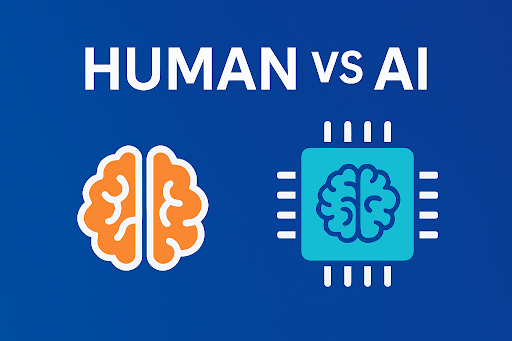
What Real SEO Copywriters Do That AI Tools Still Miss

AI can write content fast. SEO copywriters still write it effectively. The content world is shifting fast because speed sells. AI tools can crank out thousands of words in minutes. Headlines, product descriptions, FAQs, entire landing pages — all generated without blinking. At first glance, this feels like a game-changer. And in some ways, it is.
But speed isn’t a strategy and volume isn’t quality. And the truth is that a lot of AI-written content looks better than it performs.
SEO copywriting goes far beyond stringing keywords into paragraphs. It focuses heavily on making content do something. Rank, yes. But also influence, convince, and move. That’s the part AI still can’t grasp.
Intent
Most AI-generated copy checks the surface-level SEO boxes: keyword usage, headers, internal links, and basic structure. But hitting those points doesn’t mean the content actually aligns with what the searcher needs.
Search intent is rarely literal. A query like “best wireless headphones for running” isn’t just asking for a product list. It’s asking: Will these stay in my ears? Will they survive sweat? Can I control them easily while moving? AI tools tend to skim the surface, listing specs and repeating product names, without understanding what the searcher is really solving for.
Human writers dig into that intent before writing a single line. They consider not just what the person is searching, but why. That allows them to frame content in a way that directly answers the real question, not just the query.
Here’s what goes into determining intent:
- Search term analysis: Not just keywords, but modifiers and phrasing (e.g., “best,” “vs,” “cheap,” “in 2024”)
- SERP review: What Google is already ranking for that query tells you what it thinks people want
- Audience understanding: The needs, pain points, and motivations behind the search
- Stage of the funnel: Is this informational, transactional, or something in between?
- Competitive content mapping: Identifying content gaps and weaknesses in top-ranking pages
When the intent is misunderstood, the content might still rank, but engagement metrics will suffer. High bounce rates, low time on page, low CTR from SERPs — all signs that the content didn’t meet expectations. Google watches those behaviors closely. Intent alignment directly affects rankings.
That’s one of the key things professional SEO copywriting can offer. That’s why their content tends to perform longer, earn better user signals, and build more durable rankings.
Tone, Voice, and Consistency
Brand voice isn’t a prompt. It’s a system built across every touchpoint. AI tools are getting better at imitating tone, but they don’t understand tone. They sample it. They reproduce fragments.
Real copywriters don’t just match tone; they build it. They carry a company’s identity across landing pages, social posts, and blog content. The best ones protect voice consistency like editors protect grammar.
This matters because tone builds trust. Readers notice when something feels off. And when your tone fluctuates between pages, trust erodes.
Generic Patterns and Repetition Undermine Trust
Most AI tools don’t know your business. They don’t understand your product, your audience’s hesitations, or the real-world context behind what you sell. As a result, the output tends to be generic. Sentence structures repeat and punctuation patterns also become predictable.
Certain phrases start popping up everywhere and once you notice them, you can’t unsee them. Readers feel that too. It creates a sense that the content isn’t credible, even if the facts are technically correct.
Even if you use AI as part of your workflow, someone still needs to own the message. That means an experienced copywriter or editor who knows the company’s background, checks all claims and keeps the tone on brand. Without that, the copy might fill space but fail to build trust.
AI Still Struggles With Factual Accuracy
AI models aren’t researchers. They don’t browse reliable sources in real time. They don’t verify claims. What they generate is a guess based on patterns in their training data, which may be incomplete, outdated, or just wrong.
Recent tests show that even the most advanced reasoning models hallucinate at alarming rates. OpenAI’s o3 system, for example, fabricated information in 33% of benchmark tests involving public figures, and o4-mini demonstrated even higher hallucination rate of almost 50%. These aren’t edge cases. These are top-tier models making up details that sound convincing but don’t hold up.
What’s worse is how confidently these systems present false information. To the average reader, it all sounds authoritative — until it’s fact-checked. For legal, medical, or technical content, these mistakes are damaging.
If your content includes specific claims (pricing, compliance info, product specs, regulatory data) you cannot leave verification to a chatbot. You need a copywriter or editor who can dig into the details, trace sources, and spot red flags before the content goes live. Without that layer, you’re shipping guesswork under your company’s name.

Original Insight Still Matters
AI can summarize what’s already been said. It’s good at combining existing content and restating it, but it doesn’t originate anything. No new angle, no unique position, no first-hand experience.
Professional SEO copywriters have the edge because they interview SMEs. They mine feedback from sales calls. They look at review data. They find gaps in competitor content. That’s where insight comes from — not just reworded SERP summaries.
Google’s helpful content system updates now favor E-E-A-T (experience, expertise, authoritativeness, and trustworthiness). Pages with rehashed information that lacks depth are being quietly pushed down. And that’s where AI content often sits.
Conversion Is Still a Human Job
You can teach AI the format of a CTA. But you can’t teach it when someone actually needs to see one. Great SEO copy doesn’t just inform. It nudges.
Conversion-focused writing means knowing when to push, when to pause, and when to add just enough friction to create commitment. That comes from studying user flow, testing copy changes, analyzing bounce and exit rates.
A professional copywriter knows how to sell without shouting. That subtlety’s hard to automate.
Search Is Changing Fast
Search is moving beyond keywords. Google’s algorithm updates, especially since late 2023, now weigh site experience, author transparency, and topical authority more heavily. Pages need to read like they came from a credible source.
AI-generated content can produce correct information, but it rarely feels credible. It sounds like it was made in a vacuum. Real SEO copywriting brings proof points, sourcing, opinion, and clarity.
Writers know how to work structured data into content without killing flow. They know which search features to target. They build articles with passage indexing and People Also Ask in mind. AI just mimics surface patterns.
Content That Ages Well
There’s a shelf life to mass-produced content. You’ll find hundreds of pages titled "Top 10 CRM Tools for 2023," many of which are indistinguishable. Most were written by bots. Few will be updated. Fewer still will rank long-term.
Human-written pages, especially those with strong internal linking and editorial oversight, perform better over time. They’re built with longevity in mind. That means fewer rewrites and better ROI.
Search Engines Are Watching Behavior, Not Just Words
Google uses engagement signals (dwell time, pogo-sticking, repeat visits) to measure content quality. Pages that draw in traffic but bounce quickly send bad signals. Often, that’s AI content doing just enough to rank but not enough to retain.
Professional SEO copywriting considers flow, formatting, pacing, and UX. It’s written to hold attention, not just attract it. That’s not something you can measure in a word count or optimize with a prompt.

Combining AI with Human Strategy
This isn’t an argument to ditch AI. Used properly, it helps. Outlines, topic research, and SERP snapshots are all useful. But the final output needs human hands.
It takes human judgment to decide which keyword to target based on business goals, human creativity to frame a concept in a way that earns links, and human oversight to ensure the content fits into the broader SEO strategy.
What works best today is a layered approach. That’s where performance lives. Until AI can think strategically, manage nuance, and write with intent, professional SEO copywriters remain not just relevant, but necessary.